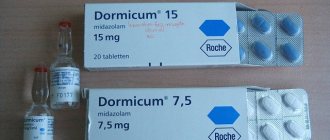Instructions for use GABAGAMMA
Skin rash combined with eosinophilia and systemic symptoms (DRESS syndrome)
Severe, life-threatening systemic hypersensitivity reactions, such as DRESS syndrome (skin rash combined with eosinophilia, fever and systemic symptoms), have been reported with the use of anticonvulsants, including gabapentin.
Early manifestations of hypersensitivity reactions, such as fever or lymphadenopathy, may develop when the rash is not yet apparent. If the above symptoms appear, the patient should be immediately examined by a doctor. If other causes of DRESS syndrome cannot be identified, gabapentin should be discontinued.
Anaphylaxis
The use of gabapentin may lead to the development of anaphylaxis. Signs and symptoms of reported cases have included difficulty breathing, swelling of the lips, throat and tongue, and hypotension, requiring emergency treatment. Patients should stop taking gabapentin and seek immediate medical attention if they experience signs or symptoms of anaphylaxis.
Suicidal thoughts and behavior
Depression and mood changes have been observed in patients treated with antiepileptic drugs. A meta-analysis of randomized placebo-controlled clinical trials of antiepileptic drugs found a nonsignificant increase in the risk of suicidal ideation and behavior. The mechanism for this increase is unknown, and available information does not exclude the possibility of an increased risk of suicide when taking antiepileptic drugs.
Patients should be closely monitored for signs of depression, suicidal thoughts or behavior. If signs of depression and/or suicidal thoughts or behavior occur, patients should be advised to seek immediate medical attention from a physician.
Acute pancreatitis
If acute pancreatitis develops during the use of gabapentin, discontinuation of gabapentin is indicated.
Epilepsy
Although there is no evidence of seizure resumption with gabapentin use, abrupt discontinuation of anticonvulsants in patients with epilepsy may precipitate the development of status epilepticus.
As with other antiepileptic drugs, some patients may experience an increase in the frequency of seizures or new types of seizures while using gabapentin.
As with other antiepileptic drugs, attempts to discontinue concomitant antiepileptic drugs to switch to gabapentin monotherapy in patients receiving multiple antiepileptic drugs are rarely successful.
Gabapentin is not considered effective for the treatment of primary generalized seizures, such as absence seizures, and may increase the intensity of such seizures in some patients. For this reason, gabapentin should be used with caution in patients with mixed seizures, including absence seizures.
Concomitant use with opioids
Patients who require concomitant treatment with opioids should be closely monitored for signs of CNS depression, such as somnolence, sedation, and respiratory depression. Patients using gabapentin and morphine concomitantly may experience increased gabapentin concentrations. The dose of gabapentin or opioids should be reduced appropriately.
Respiratory depression
The use of gabapentin is associated with the development of severe respiratory depression. Patients with impaired respiratory function, respiratory or neurological diseases, renal failure, concomitant use of CNS depressants, or elderly patients may be at higher risk of developing this severe adverse reaction. It may be necessary to adjust the dose of the drug in this category of patients.
Elderly patients ( over 65 years old)
There have been no systematic studies of the use of gabapentin in patients aged 65 years or older. In one double-blind study of patients with neuropathic pain, patients over 65 years of age were more likely than younger patients to develop drowsiness, peripheral edema, and weakness. Apart from these data, clinical studies in this age group have found no evidence of a different adverse event profile from that in a younger patient population.
Use in pediatrics
The effects of long-term (more than 36 weeks) use of gabapentin on learning, intelligence, and development in children and adolescents have not been adequately studied. In this regard, when deciding on the need for long-term therapy, possible risks should be taken into account.
Abuse and addiction
Cases of abuse and dependence have been reported in post-marketing studies. Patients with a history of substance abuse should be carefully assessed and monitored for signs of potential gabapentin abuse, such as dose escalation, development of tolerance.
Laboratory tests
Semi-quantitative urine protein dipstick tests may result in false positives. Therefore, if necessary, it is recommended to carry out additional analyzes using other methods (biuret method, turbidimetric method, dye tests).
Patients with rare hereditary diseases, such as lactose intolerance, lapp lactase deficiency, glucose-galactose malabsorption, should not take the drug.
Impact on the ability to drive vehicles and operate machinery
Gabapentin may affect your ability to drive and use mechanical equipment. Gabapentin affects the central nervous system and may cause drowsiness, dizziness, or other symptoms. Thus, gabapentin, even when used as directed, may reduce reaction time and impair the ability to drive vehicles or work in hazardous work. This is especially true at the beginning of treatment and after increasing the dose of the drug, as well as while taking alcohol.
Gabagamma caps. 300 mg No. 50 67162
Description
Gabagamma® Worwag Pharma GmbH & Co. KG (Germany) hard gelatin capsules 300 mg; blister 10, cardboard pack 5; EAN code: 4030674002112; No. LSR-002222/07, 2007-12-17 from Worwag Pharma GmbH & Co. KG (Germany); manufacturer: Artesan Pharma (Germany) Latin name Gabagamma Active ingredient Gabapentin * (Gabapentinum) ATX: N03AX12 Gabapentin Pharmacological group Antiepileptic drug [Antiepileptic drugs] Nosological classification (ICD-10) G40.2 Localized (focal) (partial) symptomatic epilepsy and epileptic syndromes with complex partial seizuresG53.0 Neuralgia after herpes zoster (B02.2+)G63.2 Diabetic polyneuropathy (E10-E14+ with a common fourth sign .4)R52.9 Pain, unspecified Description of dosage form 300 mg capsules: hard gelatin capsules No. 1 yellow. 400 mg capsules: orange hard gelatin capsules No. 0. Capsule contents: white powder. Pharmacological action Pharmacological action - antiepileptic. Pharmacodynamics Gabapentin is structurally similar to the neurotransmitter GABA, but its mechanism of action differs from other drugs that interact with GABA receptors (valproate, barbiturates, benzodiazepines, GABA transaminase inhibitors, GABA uptake inhibitors, GABA agonists and GABA prodrugs). It does not have GABAergic properties and does not affect the uptake and metabolism of GABA. Preliminary studies have shown that gabapentin binds to the α2-δ subunit of voltage-gated calcium channels and reduces the flow of calcium ions, which plays an important role in neuropathic pain. Other mechanisms of action of gabapentin in neuropathic pain are a decrease in glutamate-dependent neuronal death, an increase in the synthesis of GABA, and a suppression of the release of monoamine neurotransmitters. Gabapentin at clinically relevant concentrations does not bind to receptors for other drugs or neurotransmitters, including GABAA, GABAB, benzodiazepine, glutamate, glycine, or N-methyl-d-aspartate receptors. Unlike phenytoin and carbamazepine, gabapentin does not interact with sodium channels in vitro. Gabapentin partially attenuated the effects of the glutamate receptor agonist N-methyl-d-aspartate in some in vitro tests, but only at concentrations greater than 100 µM, which is not achieved in vivo. Gabapentin slightly reduces the release of monoamine neurotransmitters in vitro. Pharmacokinetics The bioavailability of gabapentin is not proportional to the dose. So, as the dose increases, it decreases. After oral administration, Cmax of gabapentin in plasma is reached within 2–3 hours. The absolute bioavailability of gabapentin in capsules is about 60%. Food, incl. with a high fat content, has no effect on pharmacokinetics. The clearance of gabapentin from plasma is best described by a linear model. T1/2 from plasma does not depend on the dose and averages 5–7 hours. Pharmacokinetics does not change with repeated use; Steady-state plasma concentrations can be predicted from the results of a single dose of the drug. Gabapentin practically does not bind to plasma proteins (<3%) and has a volume of distribution of 57.7 L. It is excreted exclusively by the kidneys unchanged and is not metabolized. The drug does not induce mixed-function oxidative liver enzymes involved in drug metabolism. Plasma clearance of gabapentin is reduced in the elderly and patients with impaired renal function. The elimination rate constant, plasma clearance, and renal clearance are directly proportional to creatinine clearance. Gabapentin is removed from plasma during hemodialysis. In patients with impaired renal function and patients receiving hemodialysis treatment, dose adjustment is recommended (see "Dosage and Administration"). Indications for the drug Gabagamma®: complex therapy of partial seizures with or without secondary generalization in adults and children over 12 years of age; pain syndrome in diabetic neuropathy; postherpetic neuralgia in adults. Contraindications: hypersensitivity to any of the components of the drug; acute pancreatitis; hereditary galactose deficiency; lactase deficiency; glucose-galactose malabsorption. With caution: renal failure (see "Dosage and Administration"); psychotic illnesses. Use during pregnancy and breastfeeding There is no data on the use of the drug in pregnant women, so gabapentin should be used during pregnancy only if the expected benefit to the mother outweighs the possible risk to the fetus and newborn (developmental defects, slowed mental and physical development). Gabapentin is excreted in breast milk, so breastfeeding should be avoided during treatment. Side effects Cardiovascular system: symptoms of vasodilation or increased blood pressure, palpitations. Digestive tract: flatulence, anorexia, gingivitis, abdominal pain, constipation, dental disease, diarrhea, dyspepsia, increased appetite, dry mouth or pharynx, nausea, vomiting, dental disease, increased activity of liver transaminases, hepatitis, jaundice, pancreatitis. Blood system, lymphatic system: purpura (most often described as bruising resulting from physical trauma), leukopenia, thrombocytopenia. Musculoskeletal system: arthralgia, back pain, increased bone fragility, myalgia. Nervous system: dizziness; headache, hyperkinesis, muscular dyskinesia and dystonia, choreoathetosis, strengthening, weakening or absence of reflexes; dysarthria, ataxia, nystagmus, paresthesia, convulsions, confusion, increased fatigue, asthenia, amnesia, depression, impaired thinking, hostility, emotional lability, insomnia, anxiety, drowsiness, hallucinations. Respiratory system: pneumonia, bronchitis, shortness of breath, respiratory infections, cough, pharyngitis, rhinitis. Skin and subcutaneous tissues: acne, skin itching, skin rash, peripheral edema, erythema multiforme exudative (including Steven-Johnson syndrome). Genitourinary system: urinary tract infection, impotence, urinary incontinence, acute renal failure. Sense organs: visual impairment, amblyopia, diplopia, tinnitus, otitis media. Other: fever, viral infection, weight gain, lability of plasma glucose levels in patients with diabetes, pain of various localizations. Interaction Morphine: When coadministered with gabapentin and morphine, when morphine was taken 2 hours before gabapentin, there was a 44% increase in the mean AUC of gabapentin compared to gabapentin monotherapy, which was associated with an increase in the pain threshold (cold pressor test). The clinical significance of this change has not been established; the pharmacokinetic characteristics of morphine did not change. The side effects of morphine when taken together with gabapentin did not differ from those when morphine was taken together with placebo. No interactions were observed between gabapentin and phenobarbital, phenytoin, valproic acid and carbamazepine. The pharmacokinetics of gabapentin at steady state are similar in healthy subjects and patients receiving other anticonvulsants. Concomitant use of gabapentin with oral contraceptives containing norethindrone and/or ethinyl estradiol was not accompanied by changes in the pharmacokinetics of both components. The simultaneous use of gabapentin with antacids containing aluminum and magnesium is accompanied by a decrease in the bioavailability of gabapentin by approximately 20%. It is recommended to take gabapentin approximately 2 hours after taking the antacid. Probenecid does not affect the renal excretion of gabapentin. The slight decrease in renal excretion of gabapentin with concomitant use of cimetidine is probably not clinically significant. Overdose Symptoms: dizziness, diplopia, speech impairment, drowsiness, lethargy, diarrhea and increased severity of other side effects. Treatment: gastric lavage, administration of activated carbon, symptomatic therapy. Hemodialysis may be indicated for patients with severe renal failure. Special instructions Although withdrawal syndrome with the development of seizures has not been observed during treatment with gabapentin, however, abrupt cessation of therapy with antiepileptic drugs in patients with partial seizures can provoke the development of seizures (see “Dosage and Administration”). Gabapentin is not considered an effective treatment for absence epilepsy. In patients requiring concomitant therapy with morphine, the dose of gabapentin may need to be increased. In this case, it is necessary to carefully monitor patients for the development of such a sign of CNS depression as drowsiness. In this case, the dose of gabapentin or morphine should be adequately reduced (see “Interaction with other drugs”). Laboratory research. When gabapentin is added to other anticonvulsants, false-positive results have been reported with urinary protein testing using Ames N-Multistix SG® test strips. To determine protein in urine, it is recommended to use the more specific precipitation method of sulfosalicylic acid. Impact on the ability to drive a car and use equipment. Patients should avoid driving a car, as well as performing work that requires rapid psychomotor reactions. Release form Capsules, 300 and 400 mg. 10 caps. in a blister; 2, 5 or 10 blisters are placed in a cardboard box. Manufacturer Verwag Pharma GmbH and Co. KG, Calverstraße 7, 71034 Böblingen, Germany. Manufactured by: Artesan Pharma GmbH & Co. KG. Representation/organization accepting complaints: Representative office of Verwag Pharma GmbH & Co. KG in the Russian Federation. 117587, Moscow, Varshavskoe highway, 125 Zh, bldg. 6. Tel. Conditions for dispensing from pharmacies By prescription. Storage conditions for the drug Gabagamma® At a temperature not exceeding 25 °C. Keep out of the reach of children. The shelf life of Gabagamma® is 3 years. Do not use after the expiration date stated on the package. 2000-2015. Register of Medicines of Russia The database is intended for healthcare professionals. Commercial use of materials is not permitted.
Possible product names
- Gabagamma caps. 300 mg No. 50
- GABAGAMMA 300 MG CAPS. No. 50
- GABAGAMMA 0.3 N50 CAPS
- GABAGAMMA CAPS. 300MG No. 50
- GABAGAMMA 300MG CAPS. X50
- (Gabagamma) Gabagamma caps. 300 mg No. 50





